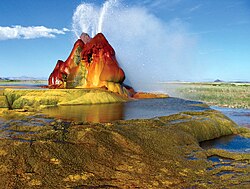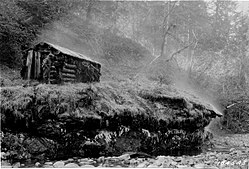| Hot springs in the United States | |
|---|---|
 |
This is a dynamic list of hot springs in the United States. The Western states in particular are known for their thermal springs: Alaska, Arizona, California, Colorado, Idaho, Montana, Nevada, New Mexico, Oregon, Utah, Washington, Wyoming; but there are interesting hot springs in other states throughout the country. Indigenous peoples' use of thermal springs can be traced back 10,000 years, per archaeological evidence of human use and settlement by Paleo-Indians. These geothermal resources provided warmth, healing mineral water, and cleansing. [1] Hot springs are considered sacred by several Indigenous cultures, and along with sweat lodges have been used for ceremonial purposes. [2] Since ancient times, humans have used hot springs, public baths and thermal medicine for therapeutic effects. [3] Bathing in hot, mineral water is an ancient ritual. The Latin phrase sanitas per aquam means "health through water", involving the treatment of disease and various ailments by balneotherapy in natural hot springs. [2]
Contents
- Alaska
- Arizona
- Arkansas
- California
- Colorado
- Florida
- Georgia
- Hawaii
- Idaho
- Illinois
- Indiana
- Massachusetts
- Montana
- Nevada
- New Mexico
- New York
- North Carolina
- Oregon
- South Dakota
- Texas
- Utah
- Virginia
- Washington
- West Virginia
- Wyoming
- See also
- References
- External links
There are several types of hot springs, including those with tasteless, colorless and odorless water; sulfur springs with a distinctive smell of "rotten eggs"; sodium chloride springs with a high salt content; iron springs which tend to be red in color and have a high iron content; copper springs that contain both copper and iron with yellow tinted water; bicarbonate or hydrogen carbonate springs containing alkaline water that can be a skin irritant; carbon dioxide springs with colorless water through which carbon dioxide gas percolates through the water giving it a "fizzy" quality; radon or radium springs that contain small quantities of naturally occurring radioactive materials; and sulphate springs that often have viscous water that is bitter in taste. [4]
Many hot springs are natural rock soaking pools that are only accessible on foot or horseback, while others are developed into resort spas.






















